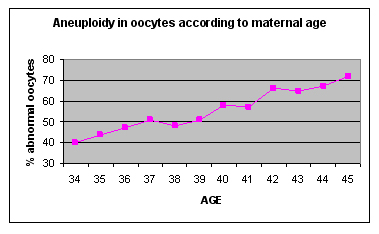As a woman ages, the chance of having an aneuploid pregnancy increases. This association is because a woman’s eggs are as old as she. Females have all of their eggs in the fetal stage therefore they are born with all the eggs they will have in their lifetime. In males, sperm is made every 65-75 days therefore the sperm is not as old as the man.
Therefore, the theory regarding aneuploidy risk and advancing maternal age is that over time the chromosomes in the egg are less likely to divide properly leading to the egg having an extra or missing chromosome. There is a significant rate of chromosome abnormalities in embryos, and the frequency of these abnormalities increases with age. Only a few pregnancies carrying an extra or missing chromosome will go to term; most will be miscarried.
The likelihood of delivering an affected child is shown in the chart below*.
| Maternal Age at Delivery |
Risk of Aneuploidy in Liveborn Child |
| 30 |
1 in 385 (or 0.26%) |
| 35 |
1 in 192 (or 0.52%) |
| 38 |
1 in 102 (or 0.98% |
| 40 |
1 in 66 (or 1.5%) |
| 45 |
1 in 21 (or 4.8%) |
| 49 |
1 in 8 (or 12.5%) |
*Hook EB. Cross PK. Schreinemachers DM. (1983) Chromosomal abnormality rates at amniocentesis and in live-born infants. JAMA, 249(15):2034-8. *Hook EB. (1981) Rates of chromosomal abnormalities at different maternal ages, Obstetrics & Gynecology, 58(3):282-5.
Table: Women of advanced maternal age are at increased risk of producing an embryo affected with a genetic disease.
| Maternal Age |
Trisomy 21 |
Trisomy 18 |
Trisomy 13 |
| 15 - 19 |
1:1250 |
1:17000 |
1:33000 |
| 20 - 24 |
1:1400 |
1:14000 |
1:25000 |
| 25 - 29 |
1:1100 |
1:11000 |
1:20000 |
| 30 - 34 |
1:700 |
1:7100 |
1:14000 |
| 35 - 39 |
1:200 |
1:2400 |
1:4800 |
| 40 - 44 |
1:60 |
1:700 |
1:1600 |
However, the frequency of aneuploidy in embryos is much higher than what would be expected looking only at affected live borns. For women between the ages of 35 to 39 years approximately 40% to 50% embryos are abnormal. For women 40 years and older, on average, greater than 50% of embryos are abnormal.

This difference in percentages in embryos versus live born is due to the fact that a pregnancy with aneuploidy is less likely to implant to the uterus or go to term. Most will be miscarried. As such, the percentage of affected pregnancies is reduced over the course of the pregnancy due to the affected pregnancies that are lost. Any embryo with a missing chromosome (monosomy) will cease to grow before implantation (except monosomy X and 21), and only few of those carrying an extra chromosome (trisomy) will go to term. The lack of implantation and loss rate of aneuploid embryos are believed to be the main reasons why the pregnancy rate in women over 40 is so low.
The goal of preimplantation genetic diagnosis for chromosomal aneuploidy is to select for and maximize the chance of transferring only chromosomally normal embryos to achieve more pregnancies, reduce the number of pregnancy losses, and reduce the number of affected offspring.